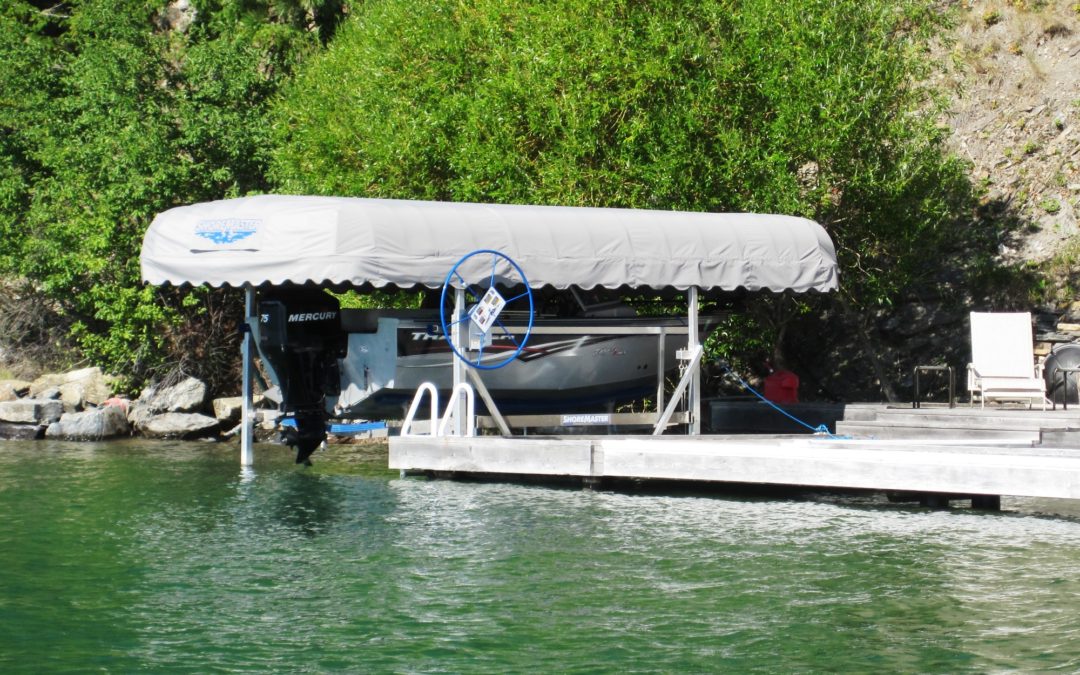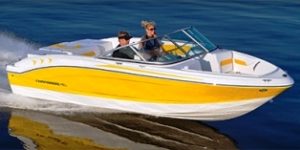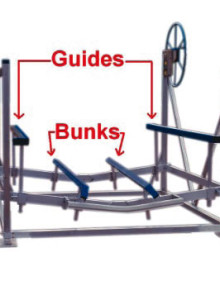
Boat Lift Calculations Part 4 of 4
Boat Lift Calculations
Boat lift calculations are explained in Part 4 of this series.
Have a new boat and don’t know what boat lift size you need? We will outline the general procedure for determining the proper boat lift size to use. Much of the information we ask for can be taken from the boat registration. To give you an accurate estimate we need as much information as possible.
Finding the Overall Weight
Where can the specifications for your boat be found?
The specifications may be provided in a brochure, on a website or a specification sheet. If you can’t find them, among other resources, try using the online NADA guides www.nadaguides.com/Boats/. Go to the website, and look for “specifications” for your model and year.
Before giving you a final recommendation on lift capacities, we usually check more than one source. We always use the higher of the two numbers if there is a difference.
For this post, we went to nadaguides.com/Boats/2013/Chaparral-Boats/H2O-19-SPORT__/32036233. We selected the 2013 Chaparral Boats H2O 19 SPORT.
The following (edited) information comes from that website.
Suncoast model weight includes the weight of the outboard motor.
[As you see below, there are (10) different engine sizes available. That means (10) different weights. Thre information is correct if they used the original motor from the manufacturer. It is best to check this information against your actual motor(s).]
115-135 HP (3.0L)
136-200 HP (3.0L – 4.3L) (included)
201-230 HP (4.3L – 5.0L ##)
231-265 HP (5.0L – 5.7L ##)
266-300 HP (5.7L #)
301-350 HP (5.7L – 8.1L ##)
351-400 HP (5.7L – 8.1L ##)
401-425 HP (8.1L ##)
426-470 HP (8.1L ##)
471-500 HP (8.1L ##)
Engine selection Key – (#) For 1993-1997 model years include 7.4L (300 HP) Mercruiser engine.
(##) Use your engine’s horsepower rating.
Under specifications, you will also find: [Condensed for our purposes]
Horsepower (bhp) 135
Length (ft-in / m) 19′ 4” / 5.9
Beam (in / m) 90 / 2.3
Dry Weight (lbs / kg) 2540 / 1152
Fuel Capacity (gal / L) 30 / 114
Please note, the dry weight provided by the manufacturer often does not account for the weight of outboard motors. Be sure you know what the number represents.
If, at any time, you would rather have PWS do the calculations for you, contact us with this information:
Model year;
Brand;
Model; and
Length of your boat.
What other items are needed for boat lift calculations?
You now have the manufacturers’ boat weight. We still need to account for:
- The weight of the fuel;
- All gear on the boat;
- Water storage;
- Non-factory additions.
Keep in mind, you will be lifting all of that weight each time your boat is raised out of the water.
IMPORTANT – EVERY boat lift manufacturer will tell you that lifts are NOT designed to transport people.
In real life, we also realize that the elderly or children often stay in the boat until it is raised. We do NOT recommend this, and you take responsibility for this action.
However, if you must take this action – allow for that added weight in your calculations. Remember, the lift can only handle it’s rated capacity. If you transport people, you are also assuming that the cables are at 100% capacity with no rust or frays. See also – https://wisconsinpws.com/lift-cable-inspection-replacement/
Now let’s look at the information provided above:
Gasoline weighs approximately 6 -7 # per gallon. Multiply this number times the capacity of your fuel tank to arrive at the weight of a full tank of gas.
Water weighs approximately 8 lbs. per gallon. Now check the capacity of all freshwater tanks, wastewater tanks and don’t forget any live wells.
Non-factory modifications – These include wakeboard towers, bimini tops, extra seating, generators, coolers, and swim platforms. It all adds up.
Gear – This include skis, wakeboards, scuba equipment, etc.
Now, add these numbers to your boat weight.
Think you’re done? Not quite yet!
Now add a “margin of safety.” This is usually between 10% and 20%. At this point, we select the next higher capacity for your lift. Why the need for all this? Here’s a simple example of why we do this.
A man picks up a ball. For our purposes, let’s say it weighs ¼ #. This presents no problem.
Next, the same ball is coming towards him at 90 mph. It hits him. It hits him. Do you think the ball “feels like” it weighs only 1/4 #? Obviously, the moving object will have the effect of “more weight’ even though it still weighs just ounces.
Why the comparison? Many times in a storm, the waves will wash against the bottom of a boat. In severe storms, the boat may actually bounce up and down on the lift as the wave rolls across the bottom. Now you have a boat weighing 2,500 – 3,200 pounds bouncing up and down. The added “weight” of the boat at this time may result in a cable breaking. This situation is especially true if the lift was not properly sized originally or the cables are not in good shape. In severe cases, the boat may be washed off the lift completely. A future post will address the insurance issue – watch for it.
Will the lift be able to take the “shock” of that bouncing? That’s why we go to the next size up. This is a common cause of cable failure. These “shocks” could cause a cable to break if they have rust or frayed strands. For more information SEE https://wisconsinpws.com/wp-admin/post.php?post=404&action=edit
The initial extra fee is small in comparison to the cost of damage to the lift or your boat. You could lose your boat & motor completely.
Do I need more Information?
What other things adversely impact a boat lift? What if your boat is in a downpour without a canopy or cover? Did you remove the drain plug while the boat is on the lift? (Don’t forget to replace it before you lower the boat).
What if you don’t know that the bilge pump is malfunctioning. These things may result in lift failure. A safety margin and a few extra dollars now may save you a lot of $$$$ later.
The point is that little things can add up and it is best to err on the side of caution.
What’s next?
The next step is to look at your boat WIDTH. In our example, we have a 90” width.
Does this mean a 96” width lift will work for you? Not even on a calm day!
We equip our boat lifts with guides to keep you centered on the bunks as shown in this example. The guides require a minimum of 6” width each – that’s 12” for a total of 102” in this example. Ok, so a 108” lift will work – right? Wrong!
If you have deep water, you can maintain control of your boat on a calm day. You might be able to get by with a 108” wide lift. However, what if the wind is blowing from the back or one side? Can you control your boat under with only 6” of “spare room”?
In shallow water, you have to “trim” (raise) the motor. Shallow water is the usual situation on the bay of Green Bay. When you trim your motor, you lose control of the direction and speed you are entering the lift. Any decent wave will push you to one side. How many days are absolutely calm?
We are going to cover this situation in more depth in an upcoming post but for now, follow our recommendation for a 120” width. This width will do three things for you:
1. Allow the “guides” to place you properly on the lift;
2. Reduce the risk of damage to your boat and dock; and
3. Give you a higher resale value.
We never have a complaint about the lift being too wide
IS YOUR BOAT CENTERED?
Although not part of the equation – is your boat centered width-wise? Failure to do so will put added strain on the cables on one side. The lift ratings are based on equal weight distribution on all of the cables.
Don’t forget – you need to correctly place your boat “forward” on the lift also. If it is too far forward or back, you have too much weight on the front or rear cables. You risk breaking a cable. The weight has to be distributed equally on the front and rear cables. In a storm, this can also be a factor in your boat being washed off the lift despite being in it’s highest position.
What happens when the boat is too far forward or backward? For more information See https://wisconsinpws.com/wp-admin/post.php?post=1944&action=edit
After all this, you now have the proper lift capacity and the correct width. That about sums it up.
By the way – What would be our recommendation for this example – a ShoreMaster vertical boat lift – SM4010 DVS. (4,000# capacity, 120” wide).
Happy Boating!
Need Help Selecting a Boat Lift For Your Home or Cottage?
Contact Pier & Waterfront Solutions TODAY!
Do you have a friend that may be interested in this information? Please share a link to this page with them.
PWS is located at 7325 St. Hwy 57. That’s 1 mile North of County MM (Hwy 42) and 3 miles South of Sturgeon Bay at the Idlewild Road intersection.
Our staff is here year-round to assist you.







